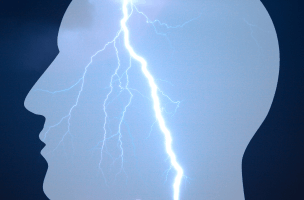Stabbing Pain In Head: What’s the diagnosis?
You’d think that a patient complaining of stabbing pain in head would be fairly easy to diagnose. Wouldn’t there be some problem right where the stabbing occurs?
Unfortunately, it’s not that simple. There are many causes for stabbing pain in the head, but there are some good ways to narrow down the causes.
Common: An Outside Cause
If there were an obvious outside cause to the pain, such as a knife in the head, you wouldn’t be taking the time to read this article. However, the outside cause is not always completely obvious. The pain may last longer than you expect, or may spread to a part of the head that you don’t expect.
For example, cold weather, or even cold water, could cause stabbing pain. Exposure to cold may not cause an instant headache, and the headache may not go away immediately. Usually, however, it should be gone within half an hour.
Another common cause is an airplane headache. The stabbing pain is usually connected to take-off or descent. Read more about this type of headache: Are You Experiencing Airplane Headache?
It’s actually common for migraine patients in particular to be more sensitive to outside stimuli. Sometimes you’ll find the stabbing pain hitting on the same side where you commonly experience migraine pain.
Stabbing Pain in Head: Nerves/Structural Problems
 When there isn’t an outside cause, the pain may be coming directly from certain nerves.
When there isn’t an outside cause, the pain may be coming directly from certain nerves.
There are various stabbing headaches that are highly related to certain nerves, such as occipital neuralgia (related to the occipital nerves, with pain in the back of the head) and classical trigeminal neuralgia (related to the trigeminal nerve, closely connected in location to parts of the nerve distribution).
In many cases certain nerves become compressed, and/or irritated. This is a common cause of stabbing pain in the head, or other parts of the body.
Irritation of nerves come from many causes – an infection or previous infection, poor posture or a previous injury. There may not even be an apparent cause.
Diagnosing Stabbing Head Pain
If there is no apparent cause, you can help your doctor to diagnose the problem by sharing the following information:
- When did the pain start? Was there anything unusual happening at the time when you started to experience this pain?
- Is the pain ever triggered by something specific? For example, does touching your face, or chewing, or turning your head sometimes or always trigger the pain? (In some cases, pain may be triggered at times but not at other times by the same thing. This will help your doctor rule out possible causes.)
- How frequent is the pain, and how long does it last? Stabbing pain usually only lasts a few seconds, but you may have repeated “stabs”. Does it come in cycles? How long has this been happening for?
- Exactly where is the pain, and does it move? This is very helpful in diagnosing nerve-related pain. Does the pain follow a path, like a streak of lightning? Is it always on the same side? Does it radiate out from a certain location? Does it come from the ear? Back of the scalp? Can you point to a specific location on your face?
If your doctor cannot find a probable cause, she may need to order a scan (such as an MRI). This will help find damage in certain locations.
Many types of stabbing head pain can be treated effectively with medication. Of course, treatment will depend very much on the type of pain you have and what your medical history is. In unusual cases when medication doesn’t work and the pain is very disabling, surgery may be an option.
Stabbing pain in the head can be difficult to diagnose, but there are good treatments available if you and your doctor can work together to get the right diagnosis.

17 October 2021 @ 10:01 pm
I have had head pain on and off for years. The pain is severe and can last for days. Ibuprofen sometimes helps but not all the time. The pain is on the left side or right side but never both sides.